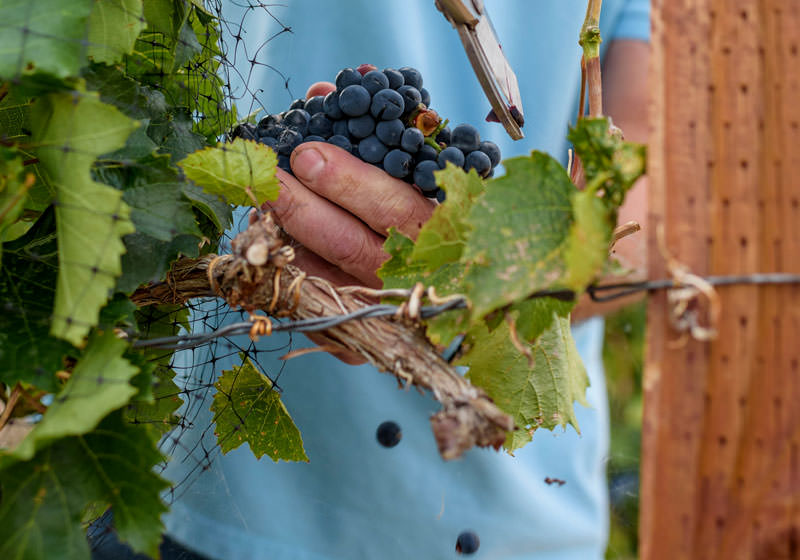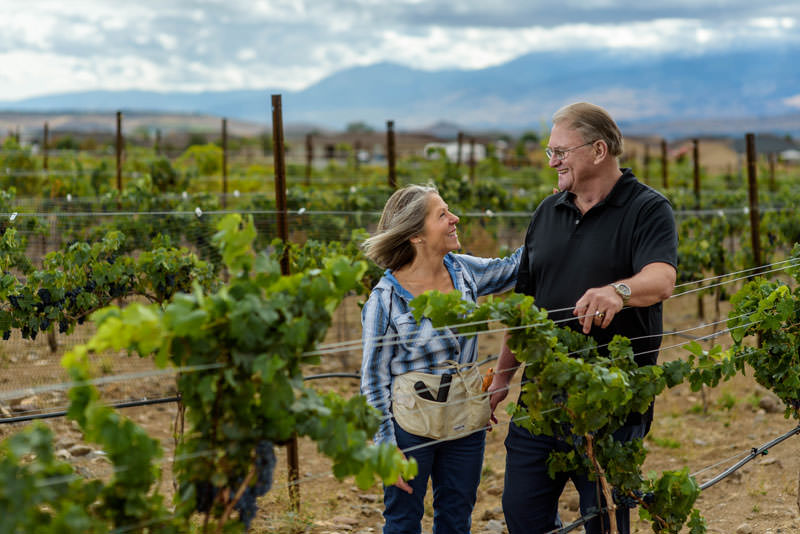Northern Nevada residents embrace the climate by creating backyard vineyards.
Close your eyes and think of two words: Northern Nevada. Do lush green vines loaded with wine grapes surrounding a gurgling fountain come to mind?
Probably not. But they should.
Since the early 2000s, an explosion of small to large vineyard plantings has taken place that’s been hard to miss. From a decorative yard containing 50 vines to the 6,000-vine Palomino Vines winery, grapevines are going in the ground across the Truckee Meadows, supported by two grassroots local organizations and showing the potential for economic growth. Fifty thousand vines and counting.
From Advocate to Vintner
A mile or so off Pyramid Highway in Spanish Springs, Adrian Dyette walks through a row of vines being fed by drip irrigators. At the head of the row is a sign that reads, “Frontenac Blanc.” He points out the tiny clusters of grapes.
“We need to start pruning these soon; you want to limit the number of clusters to get the best yield,” he says.
He points to another row of vines. The uphill vines look haggard and thin. Down slope, though, they’re growing progressively thicker and healthier.
“We really need a water profile,” Dyette says. “I think the additional water from runoff is making a big difference on the lower vines.”
We discuss water rights, the number of vines he has planted (800), and the different types of grapes (11). He apologizes for the weeds between the rows.
“We don’t use weed killer, and with the vineyard tour on hold, we haven’t bothered to clean things up as much,” he adds, referring to the Nevada Vines & Wines Backyard Vineyard Tour, which typically takes place in spring but, due to the coronavirus, was postponed until late August.
A self-taught vintner (“You can learn a heck of a lot reading and talking to people,” he says), Dyette started down the wine path during the last decade’s recession.
“I’m a real estate agent, and a lot of my people were hurting. I thought the wine business could be a jobs builder, so I joined Nevada Vines & Wines to help promote that,” he says.
His involvement led to planting vines on his property in 2015. He and his wife, Moe, do all the work, from planting to pruning (“she’s a lot better than me at that. I drive the tractor and weed,” he says), to making wine from the 400 pounds of grapes harvested last year.
“Twelve pounds of grapes equal one gallon of wine, which equals five bottles,” he explains.
Dyette plans on expanding further.
“I’d like to end up with a place where small groups can come, enjoy some wine, and sit by a pond,” he says. “The valley is growing, and we have a lot of homes right across the road. There are a lot of hurdles to become a full-on winery, but we crossed the first one when the state changed the law to allow wineries in counties with more than 100,000 people in 2015.”
We talk about processing plants and regulatory hurdles. But mostly we talk about grapes. He points to a lush vine growing on the fence that surrounds the property.
“Cab sauv,” he says. “It really likes that spot for some reason.”

Learning the Ropes
Some people plant vineyards. Others have them thrust upon them — such as Vance Demars.
“I had no idea what I was going to do with them,” he recalls.
Demars was living in Spanish Springs, looking for a home with some acreage for a shop closer to Sparks schools, when he found Dave Clark’s Shadow Lane home in December and made an offer that was accepted. In addition to the home and land, he now owned the 300-vine Shadow Lane Vineyard.
“I knew absolutely nothing about grapes or grapevines,” Demars says. “Dave asked me if I was interested in his winemaking equipment, and I told him no. Then he asked, if he could get me help, would I keep the vines?”
Clark introduced Demars to Grant Cramer. If you want to learn how to play golf, Tiger Woods would be a pretty good instructor. University of Nevada, Reno professor Cramer is pretty much the Tiger Woods of wine grapes and winemaking for the Reno-Sparks area. Cramer set up the first experimental wine grape vineyard in 1995 at UNR with his colleague, Wayne Johnson, who planted the first experimental table grape vineyard several years before.
Cramer also set up UNR’s first experimental winery. And teaches a class on winemaking. And consults with many of the local growers. And give workshops on growing and winemaking.
“I’m learning a lot,” Demars says. “It’s been great having Grant come in. He asked what I wanted out of the deal. I laughed and asked for a couple of cases of wine from my grapes.”
The Professor
“It’s really interesting going to all the different growers. Each one has a slightly different challenge,” Cramer says.
When the subject of Northern Nevada’s microclimates is raised, Cramer laughs.
“That’s for sure. Different climates, different temperatures, different soils, different water. Every pocket is different,” he says.
We discuss that first experimental vineyard.
“The first three to four winters were very hard,” he says. “But every spring, we saw the vines were coming back. We thought this could work. Those were followed by pretty light, warmer winters, and our harvests took off.”
Cramer sees this area as having great potential for wine production.
“We aren’t going to be like Napa, where every inch is planted in grapes,” he says. “But we can be like Washington state, where they’re taking advantage of grapes as the highest-value crop where they can be grown. Where you can grow alfalfa, you can grow grapes. Some areas will be more challenging, where you get more cold and frost. But you look at how Washington state’s industry has exploded, there’s no reason we can’t use that model.”
More Wining Ahead
There’s something intrinsically soothing about looking out over a vineyard — sunlight filtered through rustling leaves, the pop of color provided by grape bunches amid greens and browns. More soothing still is a glass of wine while enjoying the view … and talking trash about how your cabernet trounced the competition.
Every year, Nevada Vines & Wines holds the Vinny Awards, a competition for locally produced wines. This year, the group is working with local authorities to combine the awards with its annual Backyard Vineyard Tour in August, provided circumstances still allow for it, with social distancing as needed. In the meantime, members are working on virtual tastings and pairings. Just be sure your employer doesn’t notice the wine glass on your desk during that Zoom conference …
Reno-based writer Kurt Bickel is currently serving in a federal corrections facility for refusing to part with his corkscrew at a TSA checkpoint.
RESOURCES
For details on the “Vinnies,” virtual tastings, and dates for the Backyard Winery Tour, visit Nevada Wines & Vines: Nvandw.com
For details on local wineries and growing wine grapes locally, visit Nevada Grape Growers & Winemakers: Nggw.org
Professor Grant Cramer’s webpage: Naes.unr.edu/directory_details.aspx?hIj7_GDp0x45=13


